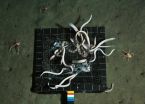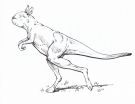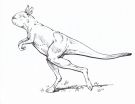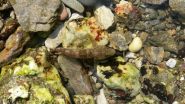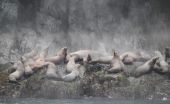(Press-News.org) A new study using a reconstruction of North American drought history over the last 1,000 years found that the drought of 1934 was the driest and most widespread of the last millennium.
Using a tree-ring-based drought record from the years 1000 to 2005 and modern records, scientists from NASA and Lamont-Doherty Earth Observatory found the 1934 drought was 30 percent more severe than the runner-up drought (in 1580) and extended across 71.6 percent of western North America. For comparison, the average extent of the 2012 drought was 59.7 percent.
"It was the worst by a large margin, falling pretty far outside the normal range of variability that we see in the record," said climate scientist Ben Cook at NASA's Goddard Institute for Space Studies in New York. Cook is lead author of the study, which will publish in the Oct. 17 edition of Geophysical Research Letters.
Two sets of conditions led to the severity and extent of the 1934 drought. First, a high-pressure system in winter sat over the west coast of the United States and turned away wet weather – a pattern similar to that which occurred in the winter of 2013-14. Second, the spring of 1934 saw dust storms, caused by poor land management practices, suppress rainfall.
"In combination then, these two different phenomena managed to bring almost the entire nation into a drought at that time," said co-author Richard Seager, professor at the Lamont-Doherty Earth Observatory of Columbia University in New York. "The fact that it was the worst of the millennium was probably in part because of the human role."
According to the recent Fifth Assessment Report of the Intergovernmental Panel on Climate Change, or IPCC, climate change is likely to make droughts in North America worse, and the southwest in particular is expected to become significantly drier as are summers in the central plains. Looking back one thousand years in time is one way to get a handle on the natural variability of droughts so that scientists can tease out anthropogenic effects – such as the dust storms of 1934.
"We want to understand droughts of the past to understand to what extent climate change might make it more or less likely that those events occur in the future," Cook said.
The abnormal high-pressure system is one lesson from the past that informs scientists' understanding of the current severe drought in California and the western United States.
"What you saw during this last winter and during 1934, because of this high pressure in the atmosphere, is that all the wintertime storms that would normally come into places like California instead got steered much, much farther north," Cook said. "It's these wintertime storms that provide most of the moisture in California. So without getting that rainfall it led to a pretty severe drought."
This type of high-pressure system is part of normal variation in the atmosphere, and whether or not it will appear in a given year is difficult to predict in computer models of the climate. Models are more attuned to droughts caused by La Niña's colder sea surface temperatures in the Pacific Ocean, which likely triggered the multi-year Dust Bowl drought throughout the 1930s. In a normal La Niña year, the Pacific Northwest receives more rain than usual and the southwestern states typically dry out.
But a comparison of weather data to models looking at La Niña effects showed that the rain-blocking high-pressure system in the winter of 1933-34 overrode the effects of La Niña for the western states. This dried out areas from northern California to the Rockies that otherwise might have been wetter.
As winter ended, the high-pressure system shifted eastward, interfering with spring and summer rains that typically fall on the central plains. The dry conditions were exacerbated and spread even farther east by dust storms.
"We found that a lot of the drying that occurred in the spring time occurred downwind from where the dust storms originated," Cook said, "suggesting that it's actually the dust in the atmosphere that's driving at least some of the drying in the spring and really allowing this drought event to spread upwards into the central plains."
Dust clouds reflect sunlight and block solar energy from reaching the surface. That prevents evaporation that would otherwise help form rain clouds, meaning that the presence of the dust clouds themselves leads to less rain, Cook said.
"Previous work and this work offers some evidence that you need this dust feedback to explain the real anomalous nature of the Dust Bowl drought in 1934," Cook said.
Dust storms like the ones in the 1930s aren't a problem in North America today. The agricultural practices that gave rise to the Dust Bowl were replaced by those that minimize erosion. Still, agricultural producers need to pay attention to the changing climate and adapt accordingly, not forgetting the lessons of the past, said Seager. "The risk of severe mid-continental droughts is expected to go up over time, not down," he said.
INFORMATION:
This week, researchers from University of Hawai'i, Norway, and the UK have shown with innovative experiments that a rise in jellyfish blooms near the ocean's surface may lead to jellyfish falls that are rapidly consumed by voracious deep-sea scavengers. Previous anecdotal studies suggested that deep-sea animals might avoid dead jellyfish, causing dead jellyfish from blooms to accumulate and undergo slow degradation by microbes, depleting oxygen at the seafloor and depriving fish and invertebrate scavengers, including commercially exploited species, of food.
Globally ...
PROVIDENCE, R.I. [Brown University] — Imagine that a time machine has transported you to the Australian outback 100,000 years ago. As you emerge, you see a huge kangaroo with a round rabbit-like face foraging in a tall bush nearby. The animal's surprising size makes you gasp aloud but when it hears you, becoming equally unnerved, it doesn't hop or lumber away on all fours and tail like every kangaroo you've seen in the present. It walks on its feet. One at a time. Like you.
In a new paper in the journal PLoS ONE, a team of researchers led by Christine Janis, professor ...
Now extinct giant kangaroos most likely could not hop and used a more rigid body posture to move their hindlimbs one at a time, according to a study published October 15, 2014 in the open-access journal PLOS ONE by Christine Janis from Brown University and colleagues.
The "short-faced," large-bodied sthenurine kangaroos–a now extinct relative to modern-day kangaroos–first appeared in the middle Miocene and became extinct in the late Pleistocene. The largest of these kangaroos had an estimated body mass of 240 kg, almost three times the size of the largest ...
Turning the street lights off decreased the number of grounded fledglings, according to a study published October 15, 2014 in the open-access journal PLOS ONE by Airam Rodríguez and colleagues from Phillip Island Nature Parks, in Victoria, Australia, and Estación Biológica de Doñana, in Spain.
Thousands of birds are attracted to lights–sometimes referred to as light-pollution–every year worldwide during their first flights from their nests to the open ocean, a phenomenon called 'fallout.' Short-tailed shearwater breeding on the coast of ...
People who risk their lives to save strangers may do so without deliberation, according to an analysis of statements from more than 50 recognized civilian heroes, conducted by David Rand from Yale University and colleagues published October 15, 2014 in the open access journal PLOS ONE.
Scientists studying human cooperation recruited hundreds of participants to rate 51 statements made during published interviews by recipients of the Carnegie Hero Medal, given to civilians who risk their lives to save strangers. Study participants as well as a computer text analysis algorithm ...
Research from the University of Exeter has revealed that the rock goby (Gobius paganellus), an unassuming little fish commonly found in rock pools around Britain, southern Europe, and North Africa, is a master of camouflage and can rapidly change colour to conceal itself against its background.
Whether hiding from predators or from families hunting in rock pools, the rock goby can change both its colour and brightness to match its background in just one minute.
Dr Martin Stevens from the Centre for Ecology and Conservation at the University of Exeter's Penryn Campus ...
An investigation into how patient outcomes are assessed in clinical trials has revealed a worrying lack of consistency, raising concerns about funding being wasted on the acquisition of poor quality data.
Information collected through clinical trials plays a crucial role in improving the standard of patient care. Patient Reported Outcomes (PROs) inform our understanding of how certain treatments and interventions work by evaluating their effectiveness, and any potential side effects, from the patient perspective.
Patients in trials are commonly invited to fill in questionnaires ...
NEWPORT, Ore. – Pacific sleeper sharks, a large, slow-moving species thought of as primarily a scavenger or predator of fish, may be preying on something a bit larger – protected Steller sea lions in the Gulf of Alaska.
A new study found the first indirect evidence that this cold-blooded shark that can grow to a length of more than 20 feet – longer than a great white shark – may be an opportunistic predator of juvenile Steller sea lions.
Results of the study have just been published in the journal Fishery Bulletin. The findings are important, ...
Astronomers using the National Science Foundation's Green Bank Telescope (GBT) in West Virginia, along with data from other large radio telescopes, have discovered that our nearest galactic neighbors, the dwarf spheroidal galaxies, are devoid of star-forming gas, and that our Milky Way Galaxy is to blame.
These new radio observations, which are the highest sensitivity of their kind ever undertaken, reveal that within a well-defined boundary around our Galaxy, dwarf galaxies are completely devoid of hydrogen gas; beyond this point, dwarf galaxies are teeming with star-forming ...
"If you have a coin and flip it just once, what does that tell you about the odds of heads versus tails?" asks Heather Knutson, assistant professor of planetary science at Caltech. "It tells you almost nothing. It's the same with planetary systems," she says.
For as long as astronomers have been looking to the skies, we have had just one planetary system—our own—to study in depth. That means we have only gotten to know a handful of possible outcomes of the planet formation process, and we cannot say much about whether the features observed in our solar system ...
